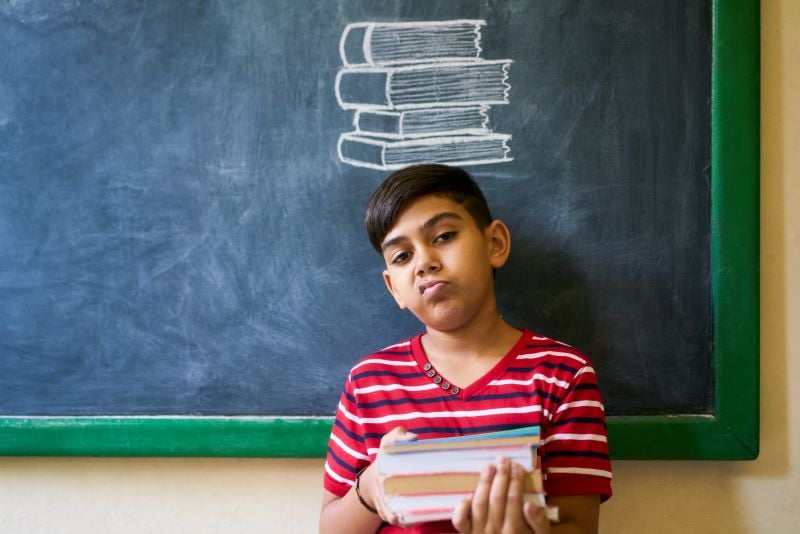 Anxiety and stress can play a major role in a child’s life and most parents do not recognize that their child is experiencing it. An average of 10-20% of school-aged children are experiencing anxiety symptoms and according to the National Institute of Mental Health, (NIMH) 25.1% of children aged 13-18 years old will experience a lifetime prevalence of anxiety.
Anxiety and stress can play a major role in a child’s life and most parents do not recognize that their child is experiencing it. An average of 10-20% of school-aged children are experiencing anxiety symptoms and according to the National Institute of Mental Health, (NIMH) 25.1% of children aged 13-18 years old will experience a lifetime prevalence of anxiety.
Children experience stress for a number of reasons and it can occur without a warning. Some of the things children stress over are divorce or family complications, academic pressure, and social pressure (the need to fit in.) According to Adelle Cadieux, a pediatric psychologist at Helen DeVos Children’s Hospital in Grand Rapids, Michigan says “Children and adolescents who are under stress will have changes in moods or behavior.”
Although signs of anxiety and stress vary in children, it is important to look out for some of these signs:
- Excessive negative behavior
- Feeling “sick” frequently
- Over tired
- Headaches
- Mood swings
- Chest pains
Anxiety, depression, and stress are hard topics to address and help fix in children. Before taking a step into seeking additional help with therapy and medications, try some of these methods to help your child.
Make time for PDF. PDF stands for playtime, downtime, and family time. These three things are very important for children because without them, they become more stressed in their studies. These tools are fundamental for a child’s academic achievement as well as their overall well-being. It is important to give your child a break. Maybe instead of telling them to get their work done right away, let them have a snack or let them watch a show, read a book, or any activity they enjoy to do in their spare time. This will help them relax and not feel overwhelmed. Lastly, engage with your child. Incorporating family time will help not only strengthen the family bond, but give kids the experience of unconditional love, acceptance and support. Eat meals together, read together, take walks, and practice family traditions.
Teach them positive thinking. This starts within the parent. If you practice positive thinking and show it, your children will be more likely to do it too. Children look up parents. Make sure to be a role model to them by demonstrating positive thinking and showing them how you manage yourself when you are stressed. This may mean deliberately slowing down your own speech, taking a few deep breaths to relax, and working to ensure that your facial expression conveys that you are calm. Maybe you had a bad day at work and messed up an important document. Don’t over think and overreact. Let yourself know it’s okay. Once it is reached in yourself, show this skill and mindset to your child. This will help them better react to a “bad situation” and think hey this might be bad, but there might be some light at the end of the tunnel.
Let them know it’s okay to be imperfect and make mistakes. Not every day is going to be perfect. Some days will be amazing, some hard, and some days will be absolutely terrible. Let them know it is okay to make mistakes. Failure and mistakes are a part of growing and learning from them. Reinforce this with the previous method of positive thinking.
Encourage them to face their fears. We are all scared of something and when we are afraid of situations, we avoid them. However, avoidance of anxiety-provoking situations maintains the anxiety. According to Psychology Today, a child should face their fears. “If a child faces his or her fears, the child will learn that the anxiety reduces naturally on its own over time. The body cannot remain anxious for a very long period of time so there is a system in the body that calms the body down. Usually your anxiety will reduce within 20-45 minutes if you stay in the anxiety-provoking situation.”
Practice relaxation exercises. Children have a lot going on. Having a relaxation method to turn to will help reduce stress and anxiety. Try your best to implement relaxation based activities to help them cool down from their busy lives. These activities can be yoga, meditation, coloring, or reading. When it comes to yoga and meditation, getting a child to practice this can be hard. It is best to do these activities with them. Being engaged will help them become more engaged and willing to try it out and eventually they might do it on their own.
Regular and balanced sleep schedule. Sleep is one of the most crucial things people need. Without the proper amount of sleep, children can become restless, moody, and unambitious. Kids who get enough sleep are likely to be less irritable and better able to handle school stress. It is important to not only set a bedtime during the week, but on the weekends too. Set a bed time and stick to it. Make sure to include a 30-45 minute bed time routine that is done every night. Doing this will help your child transition from school and activities of the day to the relaxed and comfortable state necessary to fall asleep. Routines can include shower, reading, breathing exercises, or peaceful music before bed.
Lessen the chaos. “A rushed child is never a calm child,” said Lori Lite, author of Stress Free Kids: A Parent’s Guide to Helping Build Self-Esteem, Manage Stress, and Reduce Anxiety in Children. As adults, when we are doing too many things at once we become overwhelmed and stressed out. The same goes for children. Children now a days are bombarded with extracurricular activities and are always on the go. It is important to give your child the time they need to relax. Give them a moment to catch their breath and do what they need to do to calm down and relax.
References:
“Any Anxiety Disorder Among Children.” National Institute of Mental Health. U.S. Department of Health and Human Services. Web. 20 Nov. 2017.
“Identifying Signs of Stress in Your Children and Teens.” American Psychological Association. American Psychological Association. Web. 20 Nov. 2017.
“School Stress: 10 Ways Parents Can Help Kids Manage Stress.” Partnership for Drug-Free Kids- Where Families Find Answers. The Partnership, 14 Oct. 2016. Web. 14 Nov. 2017.
Przeworski, Amy. “12 Tips to Reduce Your Child’s Stress and Anxiety.” Psychology Today. Sussex Publishers, 19 Feb. 2013. Web. 20 Nov. 2017.
Revelant, Julie. “10 Ways to Help Your Child Handle School Stress.” Fox News. FOX News Network, 19 Jan. 2014. Web. 14 Nov. 2017.
Steinhoff, Nane. “Students: 10 Ways to Beat Stress.” The Guardian. Guardian News and Media, 06 Nov. 2013. Web. 14 Nov. 2017.
Tartakovsky, Margarita. “Signs Your Child is Stressed & 5 Ways to Help.” World of Psychology. Psychcentral, 25 May 2016. Web. 20. Nov. 2017.





